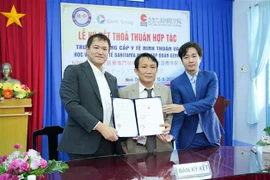 Tourists visit Hang Rai ancient coral reef, belonging to Nui Chua World Biosphere Reserve (Photo: VNA)
Tourists visit Hang Rai ancient coral reef, belonging to Nui Chua World Biosphere Reserve (Photo: VNA)Both areas preserve their rich biodiversity with rare and precious animals andplants listed in the Vietnam's Red Data Book and the International Union for Conservationof Nature (IUCN)’s Red List.
Along with preserving and researching biodiversity, the south-central provincefocuses on developing various types of ecotourism to attract tourists.
About 60km northwest of Phan Rang - Thap Cham City, Phuoc Binh National Park inBac Ai district has a total area of about 25,000ha. Located at 300m to 2,000mabove sea level on the east slope of the Da Lat Plateau, the park has a coolclimate all year round.
The park has 1,338 species of plants, of which 172 are rare species, 60 arelisted in the Vietnam's Red Data Book and 55 in the IUCN Red List. The fauna isalso diverse, with 347 species, including 110 rare and precious species, 62 inthe Vietnamese Red Book, and 40 in the IUCN list.
In particular, four Indochinese endemic species attract international interest,including the yellow-cheeked gibbon (Hylobates gabriellae), black-shanked douc(Pygathrix nigripes), Owston's palm civet (Chrotogale owstoni), and the giantmuntjac (Muntiacus vuquangensis). In addition, the park is also recognised asone of 63 bird areas and is home to the most significant number of bulls anddeer in protected areas in the country.
Meanwhile, Nui Chua World Biosphere Reserve has a total area of 106,646ha. Itis located in Ninh Hai and Thuan Bac districts, about 30km from Phan Rang - ThapCham city to the northeast. The terrain is mostly forest, sea and semi-desert.It is the only standard, typical and unique dry forest ecosystem in SoutheastAsia.
This reserve currently has 1,514 plant species, of which 54 are named in theRed List of Vietnam and the world; 766 animal species, including 48 rarespecies. In addition, with the advantage of 40km of coastal line, Nui Chua ishome to the largest coral reef in Vietnam, with over 350 species and hundredsof marine animals.
With these advantages, Ninh Thuan has been developing various types of ecotourism,such as forest tourism, sea tourism, scientific research, environmentaleducation, sightseeing and relaxation to attract domestic and internationaltourists.
Ecotourism
With diversified and unique resources and landscapes, Nui Chua World BiosphereReserve draws domestic and foreign tourists through its blue sea, white sand,colourful coral reefs, stone parks, and primeval forests.
The management board of Nui Chua National Park - Nui Chua Biosphere Reserve hascreated attractive ecotourism tours and routes for visitors to experience Vinh HyBay, Rai Cave, Lo O Stream and beaches with beautiful scenery such as Binh Tien,Vinh Hy, Cha La, Hom, and Thai An.
Nui Chua also attracts tourists and researchers to explore the "Africandry forest ecosystem in Vietnam". The reserve is also home to the Raglanand Cham ethnic minorities, with many unique cultural festivals for visitors toexplore and experience.
According to Tran Van Tiep, director of Nui Chua National Park - Nui Chua WorldBiosphere Reserve, to promote the values of biodiversity resources andnatural landscapes, many agencies organised sea tours, forest tours, and othertours to discover the mystery of the unique dry ecosystem.
Tiep said that those agencies continued to innovate new products such as seadiving tour to see corals, visiting turtle spawning areas, exploring Nui Chuatrekking routes and more. At the same time, the organisations also focus oncommunication and training on ecotourism to raise awareness of protecting thenatural environment for locals and visitors.
Meanwhile, in Phuoc Binh National Park, many tourist activities are available,such as: visiting primeval forests, rowing on rivers and streams, trekking inthe woods to see primates and butterflies, and learning about rare medicinalplants.
After sightseeing, visitors can relax at the national park's guest houses withtraditional architecture combined with modern style.
Nguyen Long Bien, vice chairman of the Ninh Thuan provincial People'sCommittee, said, along with the task of preserving and promoting the value ofbiodiversity, the province was focusing on mobilising resources to invest inthe research and conservation of Nui Chua World Biosphere Reserve and PhuocBinh National Park, as well as promoting ecological values through tourism.
Accordingly, the province promotes various forms of ecotourism following theprinciples of not changing the landscape, not causing adverse impacts onanimals and plants, not causing environmental pollution, ensuring sustainabledevelopment for conservation, and preserving and promoting indigenous culturalvalues and historical and religious heritage sites.
Cooperation on tourism
The People's Committee of Ninh Thuan has just held a conference on tourismpromotion in Hanoi with central ministries and sectors, representatives ofvarious embassies, international organisations, and many tourist businesses.
The event aimed to introduce the province's tourism products and services toinvestors and travel agencies in Hanoi. It provided an opportunity to promotecooperation in tourism development with the major market of Hanoi.
The Chairman of the Ninh Thuan People's Committee, Tran Quoc Nam, confirmedthat accommodation should increase further to meet the needs of domestic andforeign tourists when they come to the sunny land of Ninh Thuan. The provincecurrently has 203 hospitality facilities with 4,400 rooms.
Ninh Thuan aims to welcome 3.5 million visitors by 2025, gaining a totalrevenue of 2.9 trillion VND, turning tourism into a key economic sector.
With natural potential, great economic, cultural and social conditions, andguidelines on biodiversity conservation, Ninh Thuan is expected to sustainablydevelop ecotourism, create more jobs, improve the lives of the populace, and preserveits cultural identity./.





























